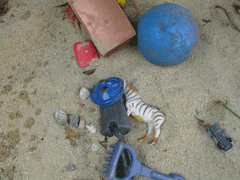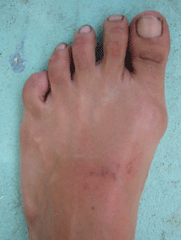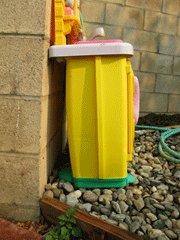Along Came a Spider
Air Date: Week of January 9, 2009

(Photo: Sara Harris)
For some of us black widow spiders are the stuff of story. But for reporter Sara Harris last summer they suddenly became extremely real.
Transcript
CURWOOD: Reporter Sara Harris lives in Southern California, where the weather is perfect not only for humans but for many species of eight-legged critters too. So Sara usually checks her garden shoes before she puts them on. Until one day, she forgot.
SARA HARRIS: Are you afraid of spiders? I am. My family shares our home with the Western black widow. No one seems more comfortable with that than my three-year-old, Minerva.
MINERVA HARRIS: I saw one black widow on the stairs, and another black widow in the corner next to my toy kitchen, under the rock.
SARA HARRIS: You see the one I killed? [smash] It’s right here.
MINERVA HARRIS: Wow, she has eight legs!
[SOUND OF DOOR, STEPS…]
SARA HARRIS: Last August, I’d been out of town for weeks, caring for my father after a serious accident. I came back to Los Angeles just in time to start my first week of graduate school. My garden shoes had been sitting there all summer, but I forgot to look before I slipped my feet into them.
It felt like a little prick. I pulled my foot out and shook the shoe. Out tumbled a shiny, black, bulbous spindly spider with a huge belly.
Argh, this is my first day of school.
I flipped the spider over, and there was the red hourglass marking.

Reporter Sara Harris’ spider bite. (Photo: Sara Harris)
While I’m on hold with the hospital, I examine the OSHA fact sheet about black widow bites.
Symptoms may include nausea, tremors, labored breathing, increased blood pressure and fever. Pain lasts 8-12 hours. Apply ice to slow absorption of the venom.
I thought, “This isn’t so bad.”
When I arrived at the hospital, they’d run out of ice. I thought, venom, venom, venom.
By the time I saw the doctor I was feeling really queasy. He explained the hospital had antivenin but it’s expensive, and they reserve it for the worst reactions.
He said that when the pain arrived, even opiates were not going to help. He gave me some anti-convulsant and he sent me home.
What happened next, I can only compare with childbirth. Everything below my neck felt like it was on fire. It lasted for 36 hours. Then, for three more weeks, my foot would swell and itch and throb.
But when the symptoms went away, something else remained.
It’s like a third eye. It will pull my attention toward cracks, like a crevice between a wall and a toy shelf.
And sure enough, every time now, I will find a shiny, bulbous, black spider. I’ve stopped killing them, mindful of the message I am sending to Minerva.
SARA HARRIS: I know there are other ones here. If I let myself concentrate, I know where they are but I don’t want to think about it, because I don’t want to scare you! Are you scared?
MINERVA HARRIS: No. I see where the holes are. I see where they live. See?
SARA HARRIS: And what do you do when you see their holes?
MINERVA HARRIS: I get my shovel, and I whack!
SARA HARRIS: Wrong answer. You call me or Papa and you don’t go near. Ok?
SARA HARRIS: Brent Karner is an entomologist at the Museum of Natural History in Los Angeles. He says that Minerva is big enough and strong enough that the black widow bite wouldn’t kill her.
KARNER: At three, she’s probably already big enough to deal with this better. I would worry more about a child one year or under.

Reporter Sara Harris has found black widows in her daughter Minerva's play kitchen. (Photo: Sara Harris)
KARNER: A healthy respect is good to have for any animal…Look at the black widow the same way. Respect it, don’t grab it. But don’t run away from it because there is a lot of joy in just being able to observe it in the first place. And they are part of the magnificent world around us.
SARA HARRIS: The magnificent world. Maybe I will get there, someday, but for now, my foot still throbs and itches when I pass the place where I slipped it into my shoe that summer afternoon.
For Living on Earth I’m Sara Harris.
CURWOOD: For more about black widow spiders, visit our website: www.loe.org
[Ashbury Heights “Spiders” from Morningstar in a Black Car (Out Of Line/Finetunes 2008)]
Living on Earth wants to hear from you!
Living on Earth
62 Calef Highway, Suite 212
Lee, NH 03861
Telephone: 617-287-4121
E-mail: comments@loe.org
Newsletter [Click here]
Donate to Living on Earth!
Living on Earth is an independent media program and relies entirely on contributions from listeners and institutions supporting public service. Please donate now to preserve an independent environmental voice.
NewsletterLiving on Earth offers a weekly delivery of the show's rundown to your mailbox. Sign up for our newsletter today!
 Sailors For The Sea: Be the change you want to sea.
Sailors For The Sea: Be the change you want to sea.
 The Grantham Foundation for the Protection of the Environment: Committed to protecting and improving the health of the global environment.
The Grantham Foundation for the Protection of the Environment: Committed to protecting and improving the health of the global environment.
 Contribute to Living on Earth and receive, as our gift to you, an archival print of one of Mark Seth Lender's extraordinary wildlife photographs. Follow the link to see Mark's current collection of photographs.
Contribute to Living on Earth and receive, as our gift to you, an archival print of one of Mark Seth Lender's extraordinary wildlife photographs. Follow the link to see Mark's current collection of photographs.
 Buy a signed copy of Mark Seth Lender's book Smeagull the Seagull & support Living on Earth
Buy a signed copy of Mark Seth Lender's book Smeagull the Seagull & support Living on Earth

